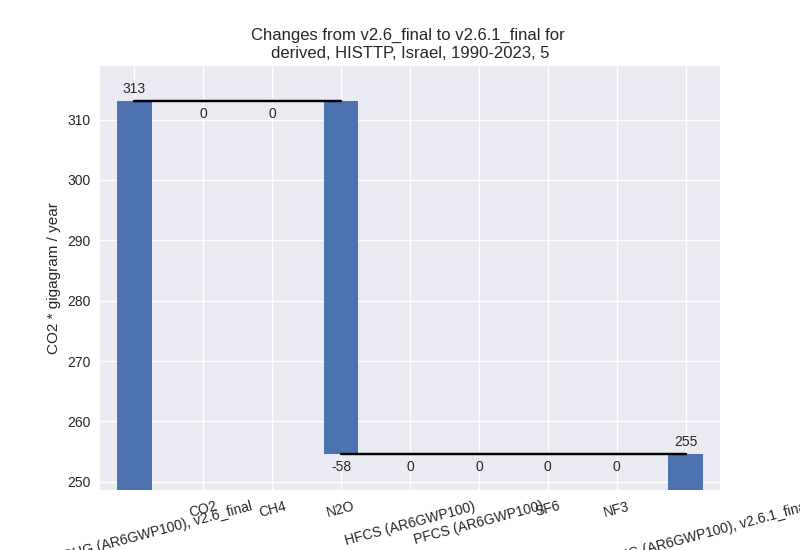Changes in PRIMAP-hist v2.6.1_final compared to v2.6_final for Israel
2025-03-19
Johannes Gütschow
Change analysis for Israel for PRIMAP-hist v2.6.1_final compared to v2.6_final
Overview over emissions by sector and gas
The following figures show the aggregate national total emissions excluding LULUCF AR6GWP100 for the country reported priority scenario. The dotted linesshow the v2.6_final data.
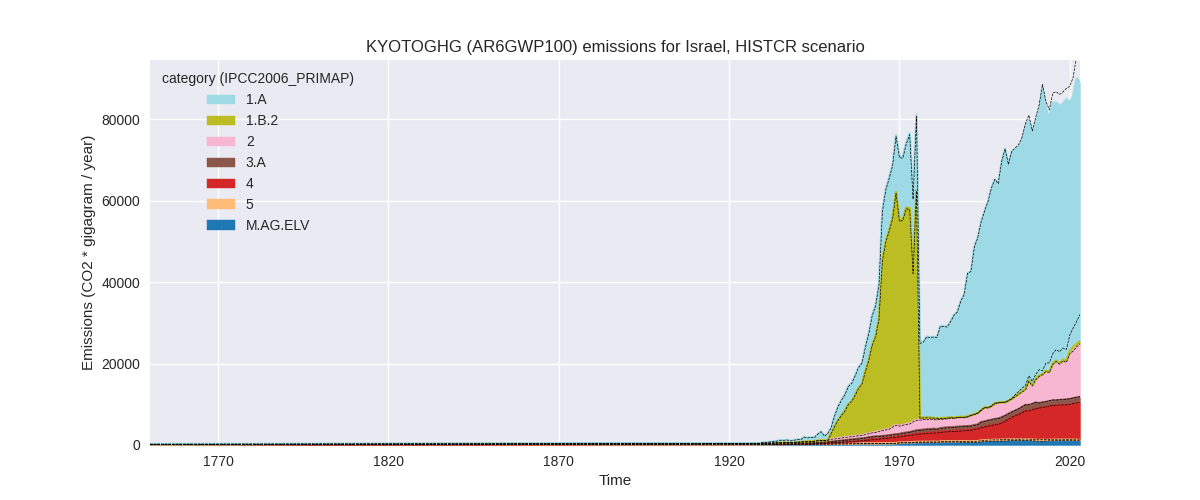
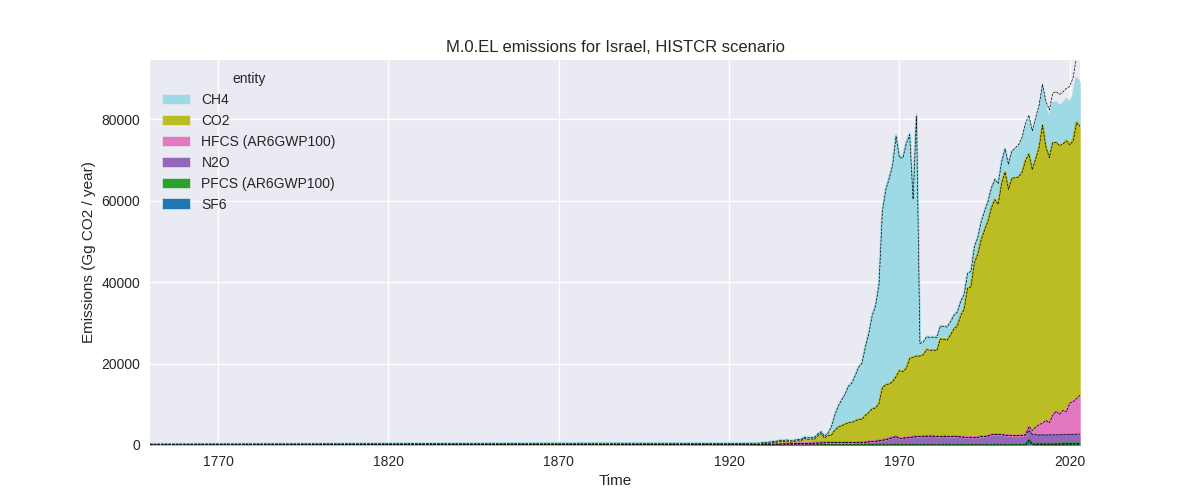
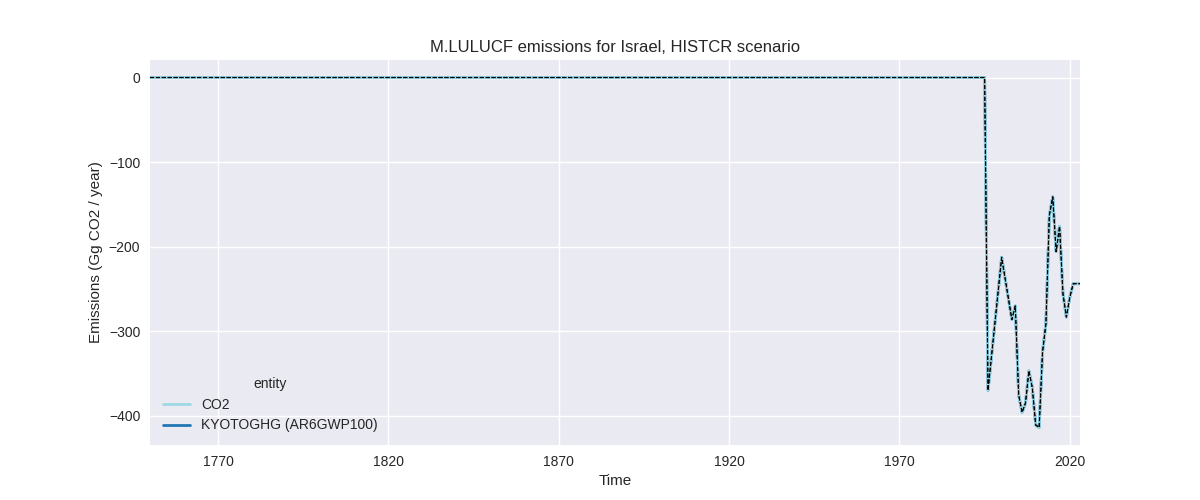
The following figures show the aggregate national total emissions excluding LULUCF AR6GWP100 for the third party priority scenario. The dotted linesshow the v2.6_final data.
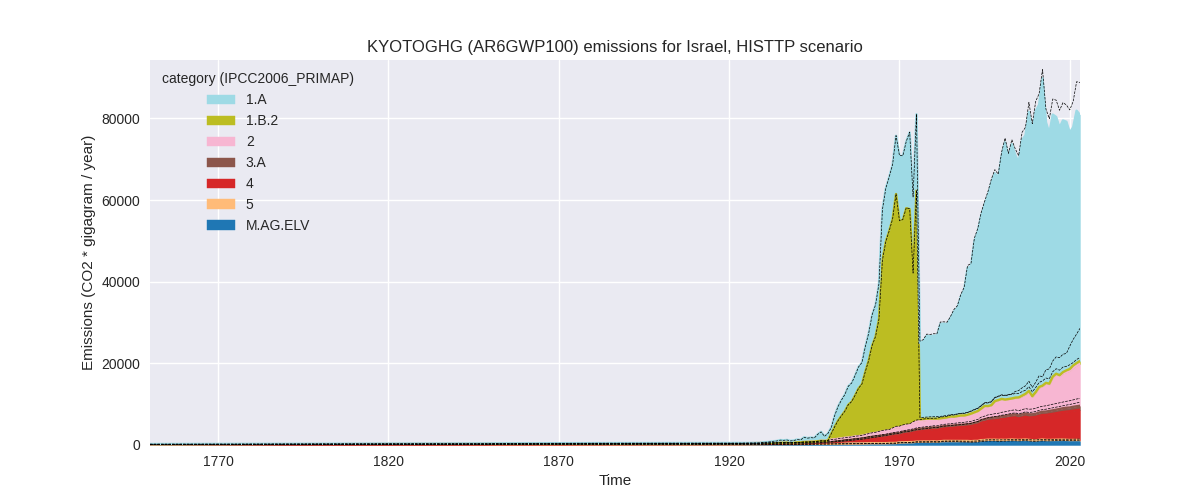
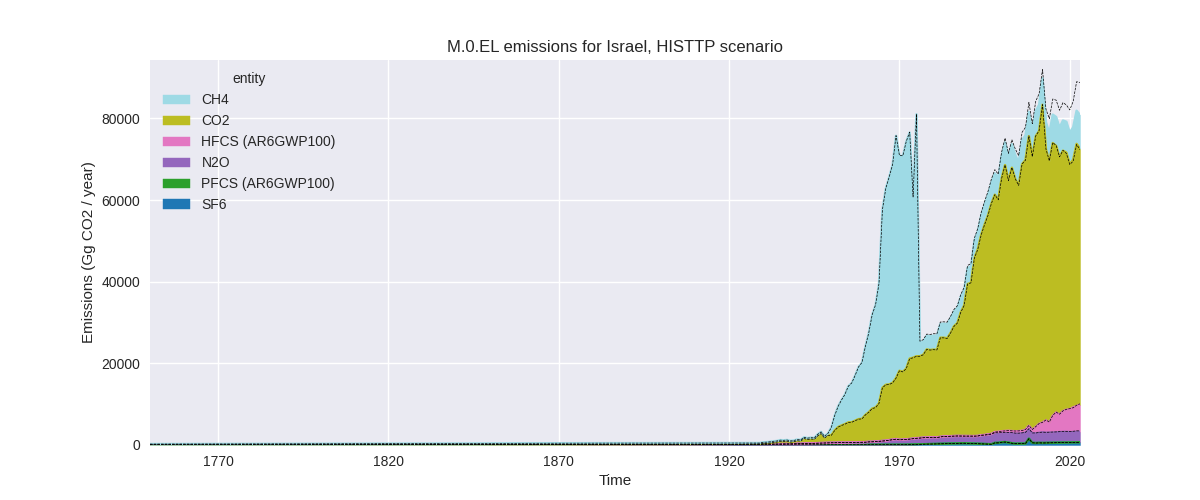
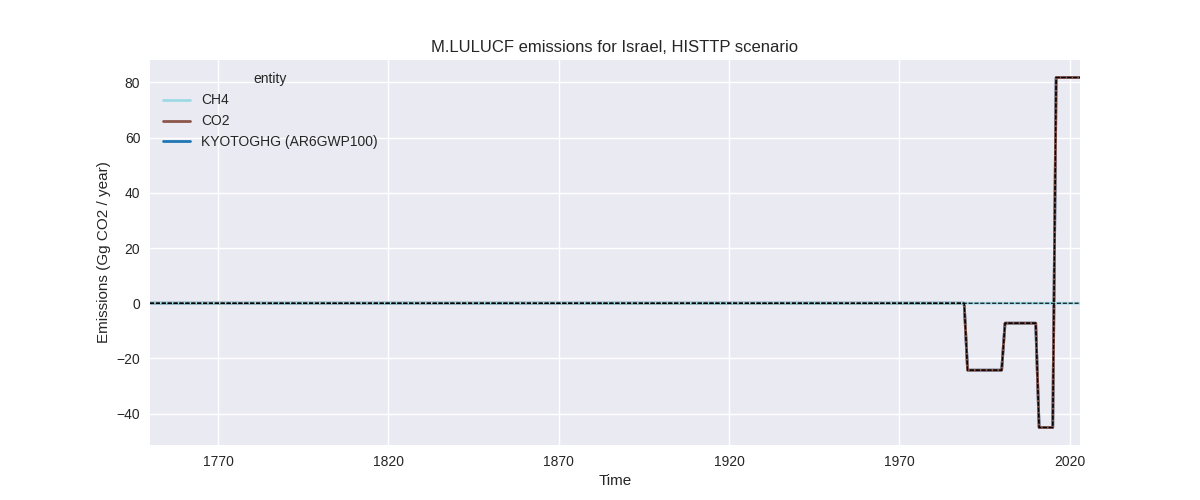
Overview over changes
In the country reported priority scenario we have the following changes for aggregate Kyoto GHG and national total emissions excluding LULUCF (M.0.EL):
- Emissions in 2023 have changed by -6.9%% (-6625.41 Gg CO2 / year)
- Emissions in 1990-2023 have changed by -1.9%% (-1383.03 Gg CO2 / year)
In the third party priority scenario we have the following changes for aggregate Kyoto GHG and national total emissions excluding LULUCF (M.0.EL):
- Emissions in 2023 have changed by -9.0%% (-7967.62 Gg CO2 / year)
- Emissions in 1990-2023 have changed by -3.4%% (-2514.84 Gg CO2 / year)
Most important changes per scenario and time frame
In the country reported priority scenario the following sector-gas combinations have the highest absolute impact on national total KyotoGHG (AR6GWP100) emissions in 2023 (top 5):
- 1: 1.B.2, CH4 with -6617.00 Gg CO2 / year (-92.6%)
- 2: 2, HFCS (AR6GWP100) with -307.62 Gg CO2 / year (-3.2%)
- 3: 2, CO2 with 302.59 Gg CO2 / year (11.6%)
- 4: 1.B.2, CO2 with 128.18 Gg CO2 / year (834.6%)
- 5: 5, N2O with -93.16 Gg CO2 / year (-32.6%)
In the country reported priority scenario the following sector-gas combinations have the highest absolute impact on national total KyotoGHG (AR6GWP100) emissions in 1990-2023 (top 5):
- 1: 1.B.2, CH4 with -1379.96 Gg CO2 / year (-88.0%)
- 2: 5, N2O with -58.46 Gg CO2 / year (-18.7%)
- 3: 2, CO2 with 32.38 Gg CO2 / year (1.2%)
- 4: 1.B.2, CO2 with 18.66 Gg CO2 / year (123.7%)
- 5: 4, CH4 with 6.70 Gg CO2 / year (0.1%)
In the third party priority scenario the following sector-gas combinations have the highest absolute impact on national total KyotoGHG (AR6GWP100) emissions in 2023 (top 5):
- 1: 1.B.2, CH4 with -6617.00 Gg CO2 / year (-92.6%)
- 2: 4, CH4 with -1614.58 Gg CO2 / year (-19.4%)
- 3: 2, CO2 with 285.85 Gg CO2 / year (12.2%)
- 4: M.AG.ELV, N2O with -136.88 Gg CO2 / year (-12.6%)
- 5: 1.B.2, CO2 with 128.18 Gg CO2 / year (834.6%)
In the third party priority scenario the following sector-gas combinations have the highest absolute impact on national total KyotoGHG (AR6GWP100) emissions in 1990-2023 (top 5):
- 1: 1.B.2, CH4 with -1379.96 Gg CO2 / year (-88.0%)
- 2: 4, CH4 with -1132.72 Gg CO2 / year (-18.4%)
- 3: 5, N2O with -58.46 Gg CO2 / year (-18.7%)
- 4: 2, CO2 with 31.40 Gg CO2 / year (1.2%)
- 5: 1.B.2, CO2 with 18.66 Gg CO2 / year (123.7%)
Notes on data changes
Here we list notes explaining important emissions changes for the country.
- No new country reported data has been included. The main change in the CR time-series is that CH4 in 1.B.2 is much lower as EDGAR data is much lower and no country reported data exists for the sector.
- For the TP scenario this is the highest change as well with an additional large contribution from waste CH4 which is also much lower in the new EDGAR data.
Changes by sector and gas
For each scenario and time frame the changes are displayed for all individual sectors and all individual gases. In the sector plot we use aggregate Kyoto GHGs in AR6GWP100. In the gas plot we usenational total emissions without LULUCF.
country reported scenario
2023
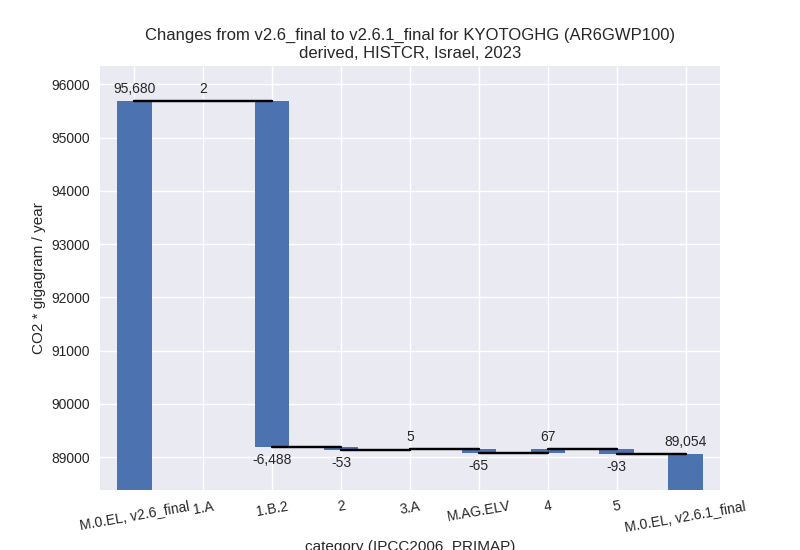
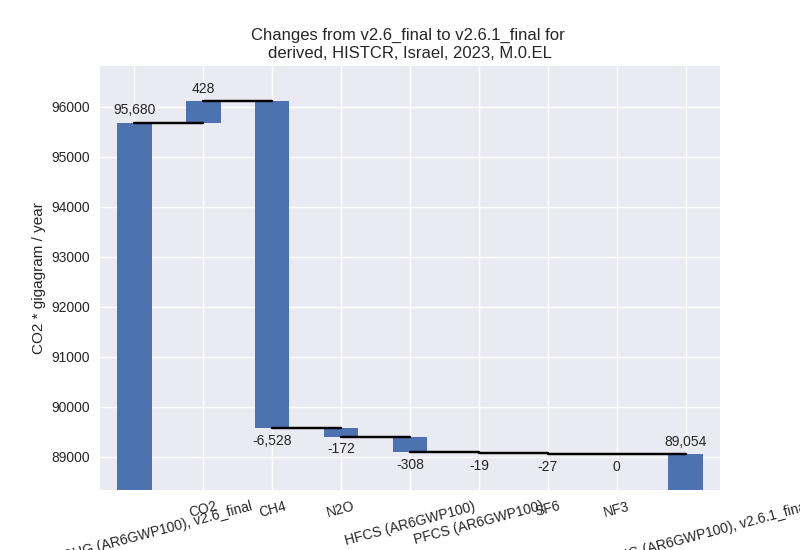
1990-2023
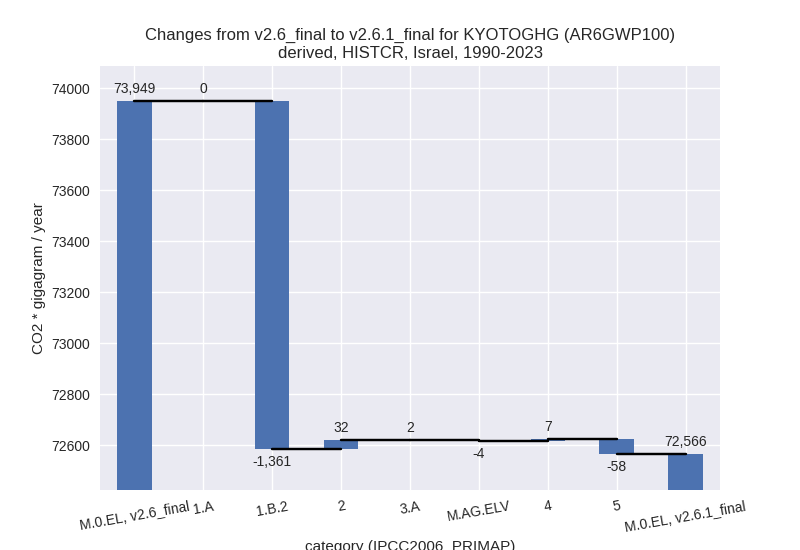
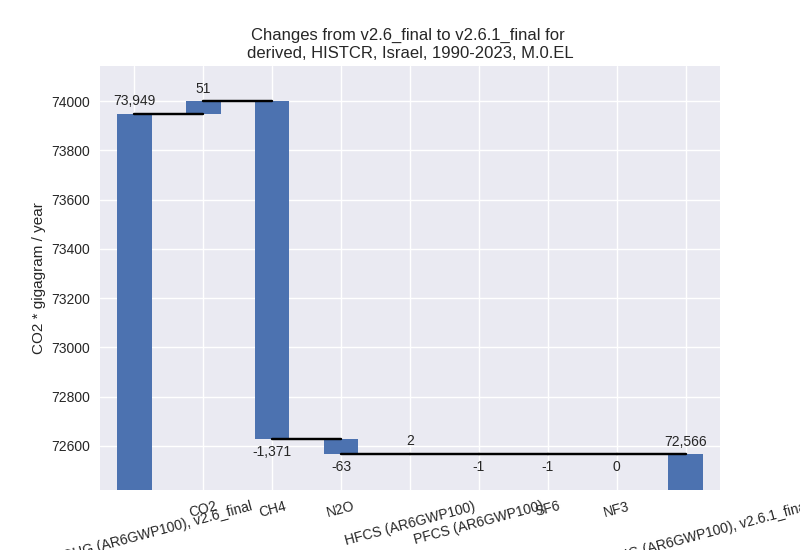
third party scenario
2023
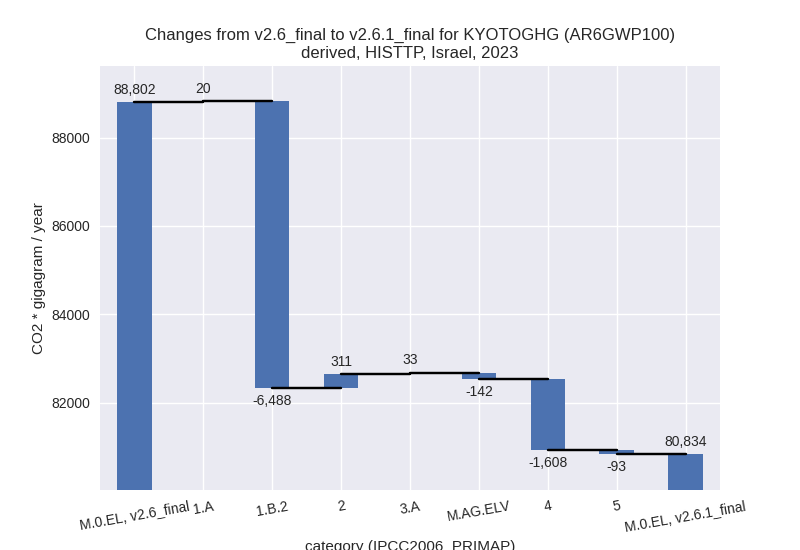
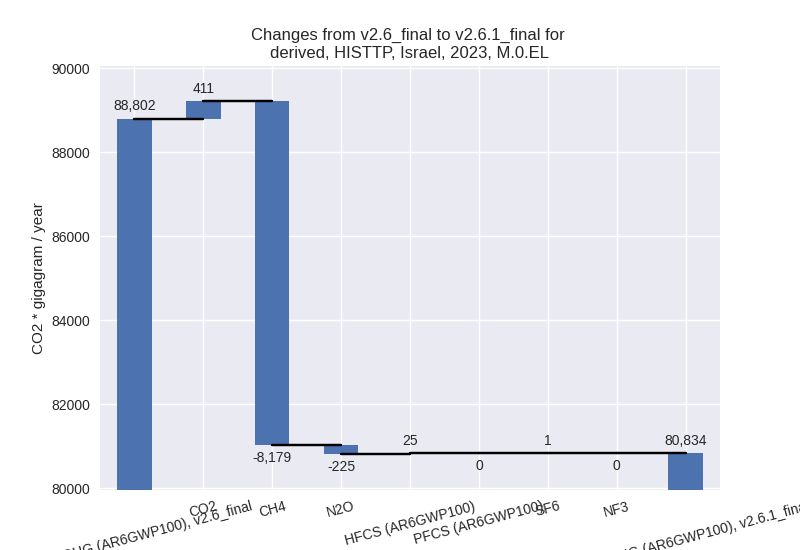
1990-2023
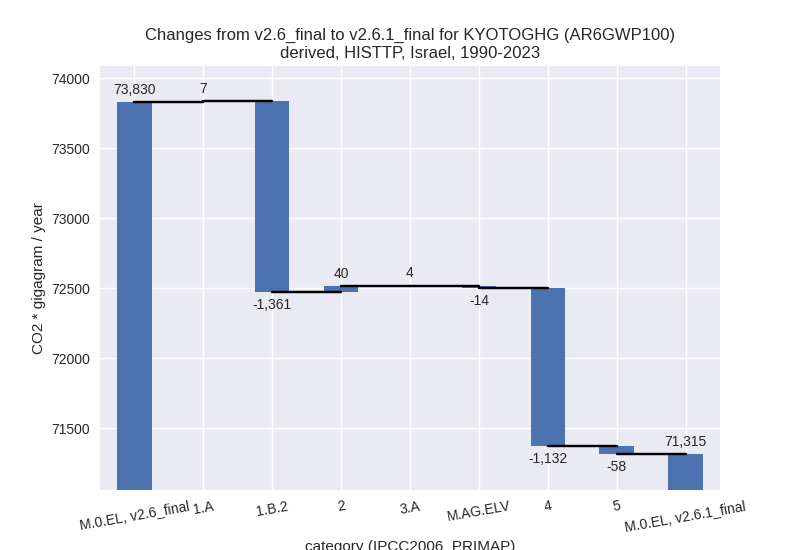
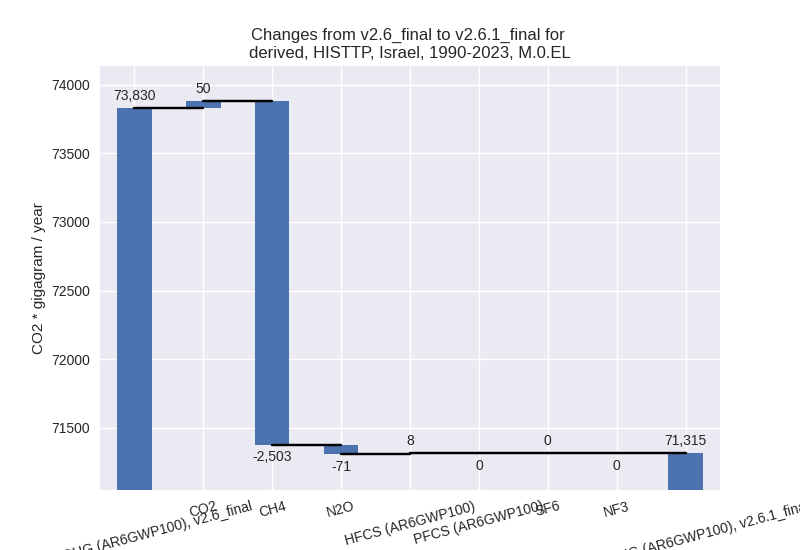
Detailed changes for the scenarios:
country reported scenario (HISTCR):
Most important changes per time frame
For 2023 the following sector-gas combinations have the highest absolute impact on national total KyotoGHG (AR6GWP100) emissions in 2023 (top 5):
- 1: 1.B.2, CH4 with -6617.00 Gg CO2 / year (-92.6%)
- 2: 2, HFCS (AR6GWP100) with -307.62 Gg CO2 / year (-3.2%)
- 3: 2, CO2 with 302.59 Gg CO2 / year (11.6%)
- 4: 1.B.2, CO2 with 128.18 Gg CO2 / year (834.6%)
- 5: 5, N2O with -93.16 Gg CO2 / year (-32.6%)
For 1990-2023 the following sector-gas combinations have the highest absolute impact on national total KyotoGHG (AR6GWP100) emissions in 1990-2023 (top 5):
- 1: 1.B.2, CH4 with -1379.96 Gg CO2 / year (-88.0%)
- 2: 5, N2O with -58.46 Gg CO2 / year (-18.7%)
- 3: 2, CO2 with 32.38 Gg CO2 / year (1.2%)
- 4: 1.B.2, CO2 with 18.66 Gg CO2 / year (123.7%)
- 5: 4, CH4 with 6.70 Gg CO2 / year (0.1%)
Changes in the main sectors for aggregate KyotoGHG (AR6GWP100) are
- 1: Total sectoral emissions in 2022 are 65855.40 Gg
CO2 / year which is 73.1% of M.0.EL emissions. 2023 Emissions have
changed by -9.2% (-6486.09 Gg CO2 /
year). 1990-2023 Emissions have changed by -2.3% (-1361.07 Gg CO2 / year). For 2023
the changes per gas
are:
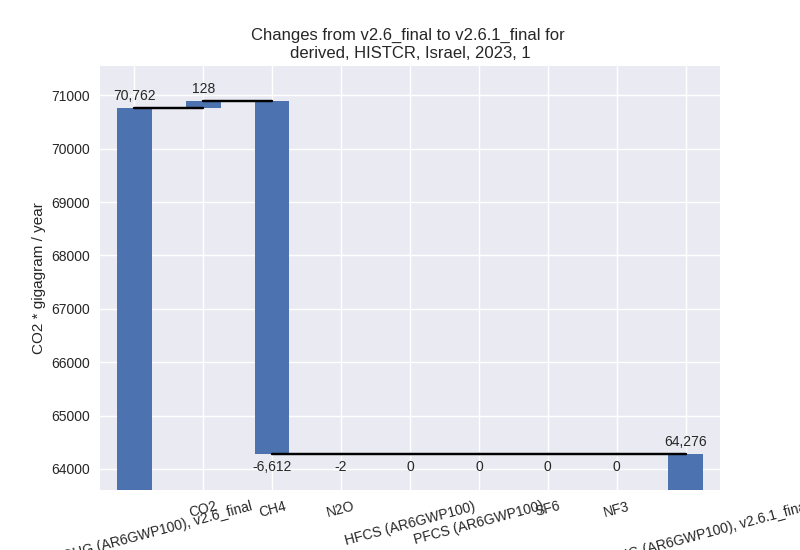
For 1990-2023 the changes per gas are: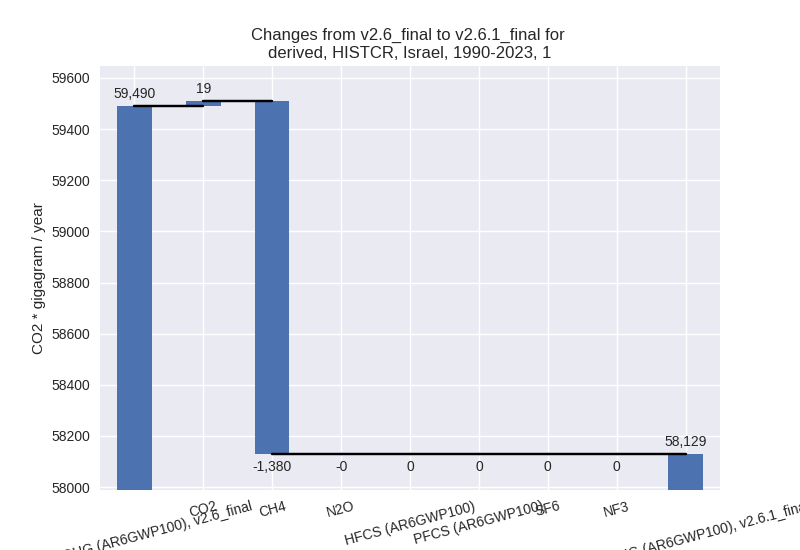
The changes come from the following subsectors:- 1.A: Total sectoral emissions in 2022 are 65250.90 Gg CO2 / year which is 99.1% of category 1 emissions. 2023 Emissions have changed by 0.0% (2.14 Gg CO2 / year). 1990-2023 Emissions have changed by 0.0% (0.13 Gg CO2 / year).
- 1.B.2: Total sectoral emissions in 2022 are 604.50
Gg CO2 / year which is 0.9% of category 1 emissions. 2023 Emissions have
changed by -90.6% (-6488.23 Gg CO2 /
year). 1990-2023 Emissions have changed by -86.0% (-1361.20 Gg CO2 / year). For 2023
the changes per gas
are:
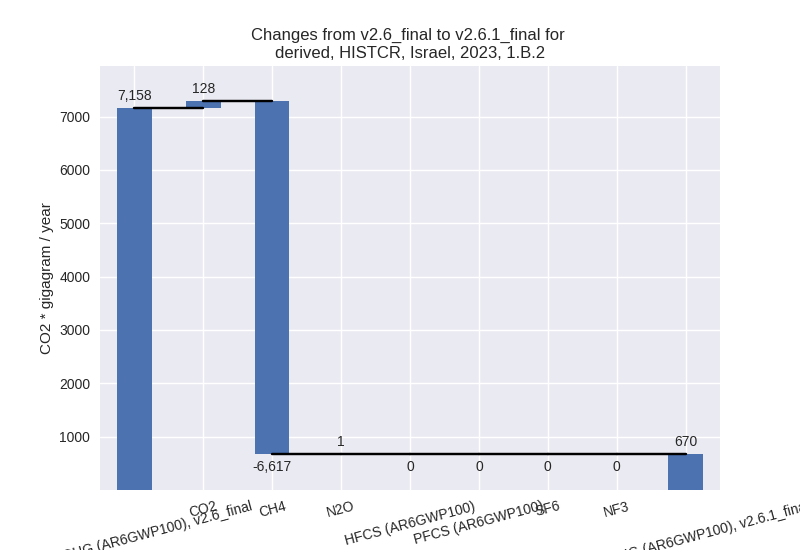
For 1990-2023 the changes per gas are: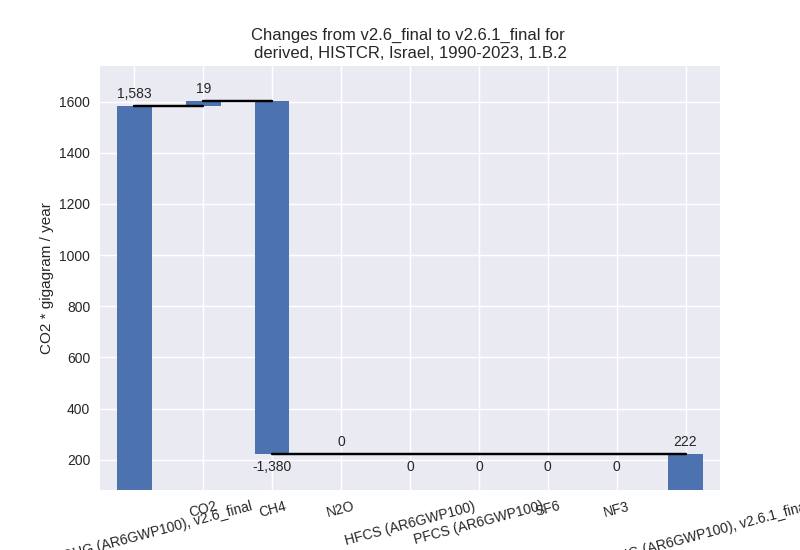
There is no subsector information available in PRIMAP-hist.
- 2: Total sectoral emissions in 2022 are 12581.50 Gg CO2 / year which is 14.0% of M.0.EL emissions. 2023 Emissions have changed by -0.4% (-53.33 Gg CO2 / year). 1990-2023 Emissions have changed by 0.6% (31.89 Gg CO2 / year).
- M.AG: Total sectoral emissions in 2022 are 2542.27
Gg CO2 / year which is 2.8% of M.0.EL emissions. 2023 Emissions have
changed by -2.3% (-59.49 Gg CO2 /
year). 1990-2023 Emissions have changed by -0.1% (-2.06 Gg CO2 / year). For 2023 the
changes per gas
are:
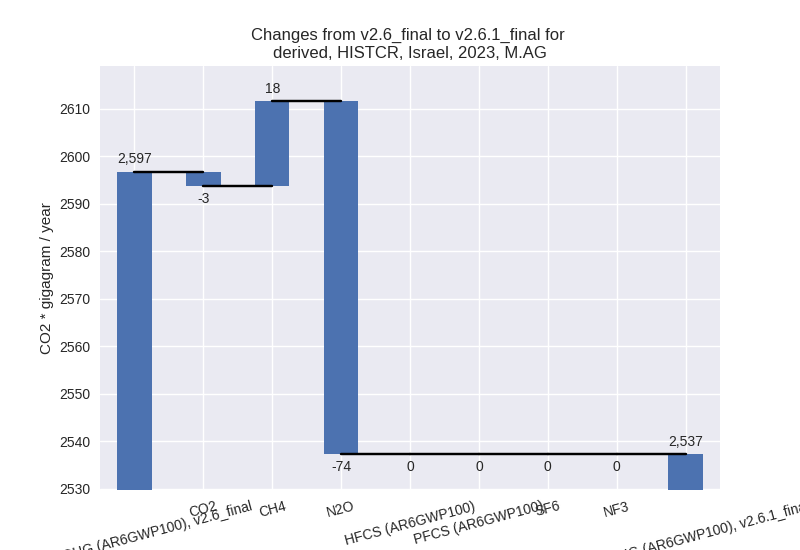
The changes come from the following subsectors:- 3.A: Total sectoral emissions in 2022 are 1445.62 Gg CO2 / year which is 56.9% of category M.AG emissions. 2023 Emissions have changed by 0.4% (5.16 Gg CO2 / year). 1990-2023 Emissions have changed by 0.1% (1.73 Gg CO2 / year).
- M.AG.ELV: Total sectoral emissions in 2022 are
1096.65 Gg CO2 / year which is 43.1% of category M.AG emissions. 2023
Emissions have changed by -5.6%
(-64.65 Gg CO2 / year). 1990-2023 Emissions have changed by -0.4% (-3.79 Gg CO2 / year). For 2023 the
changes per gas
are:
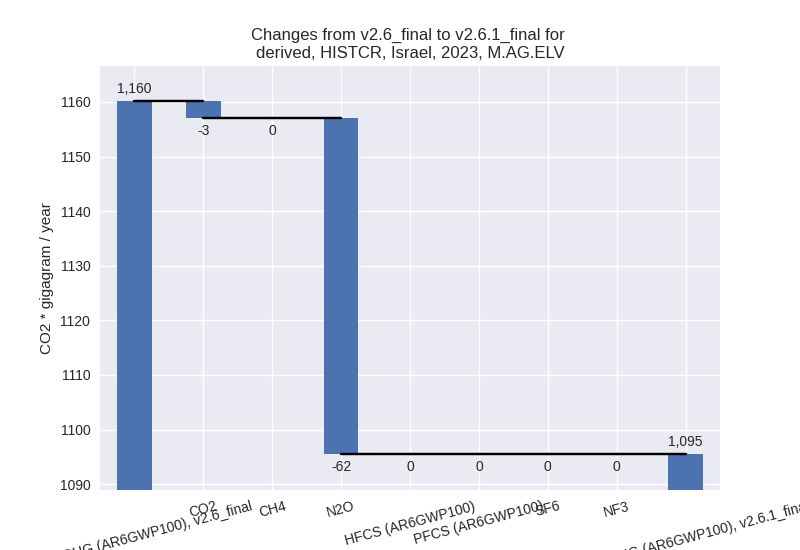
There is no subsector information available in PRIMAP-hist.
- 4: Total sectoral emissions in 2022 are 8871.63 Gg CO2 / year which is 9.9% of M.0.EL emissions. 2023 Emissions have changed by 0.7% (66.66 Gg CO2 / year). 1990-2023 Emissions have changed by 0.1% (6.67 Gg CO2 / year).
- 5: Total sectoral emissions in 2022 are 196.34 Gg
CO2 / year which is 0.2% of M.0.EL emissions. 2023 Emissions have
changed by -32.6% (-93.16 Gg CO2 /
year). 1990-2023 Emissions have changed by -18.7% (-58.46 Gg CO2 / year). For 2023
the changes per gas
are:
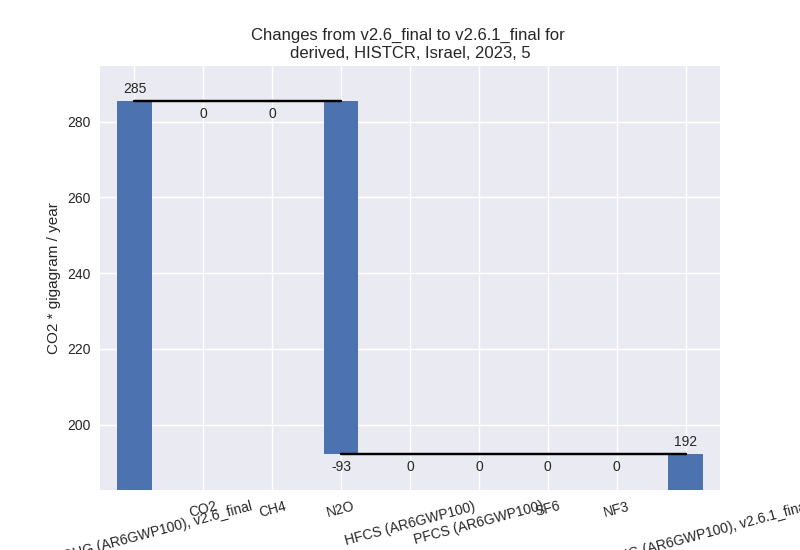
For 1990-2023 the changes per gas are: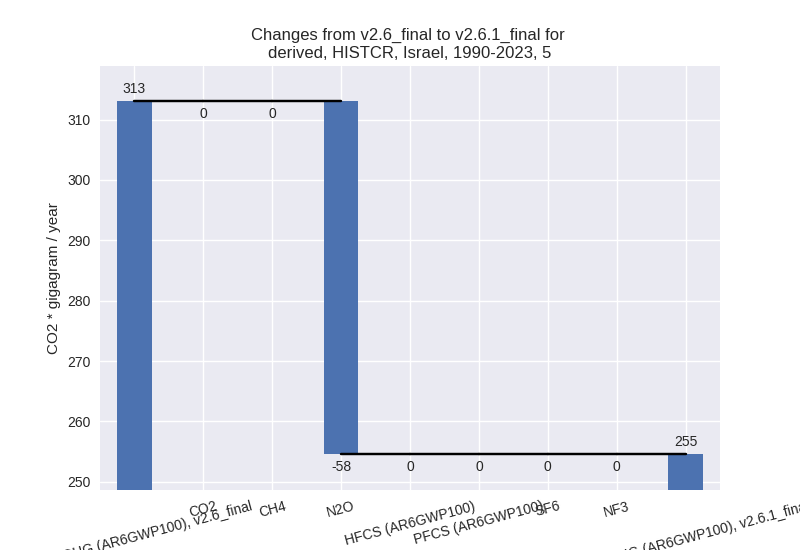
third party scenario (HISTTP):
Most important changes per time frame
For 2023 the following sector-gas combinations have the highest absolute impact on national total KyotoGHG (AR6GWP100) emissions in 2023 (top 5):
- 1: 1.B.2, CH4 with -6617.00 Gg CO2 / year (-92.6%)
- 2: 4, CH4 with -1614.58 Gg CO2 / year (-19.4%)
- 3: 2, CO2 with 285.85 Gg CO2 / year (12.2%)
- 4: M.AG.ELV, N2O with -136.88 Gg CO2 / year (-12.6%)
- 5: 1.B.2, CO2 with 128.18 Gg CO2 / year (834.6%)
For 1990-2023 the following sector-gas combinations have the highest absolute impact on national total KyotoGHG (AR6GWP100) emissions in 1990-2023 (top 5):
- 1: 1.B.2, CH4 with -1379.96 Gg CO2 / year (-88.0%)
- 2: 4, CH4 with -1132.72 Gg CO2 / year (-18.4%)
- 3: 5, N2O with -58.46 Gg CO2 / year (-18.7%)
- 4: 2, CO2 with 31.40 Gg CO2 / year (1.2%)
- 5: 1.B.2, CO2 with 18.66 Gg CO2 / year (123.7%)
Changes in the main sectors for aggregate KyotoGHG (AR6GWP100) are
- 1: Total sectoral emissions in 2022 are 62408.85 Gg
CO2 / year which is 76.2% of M.0.EL emissions. 2023 Emissions have
changed by -9.6% (-6468.63 Gg CO2 /
year). 1990-2023 Emissions have changed by -2.3% (-1354.25 Gg CO2 / year). For 2023
the changes per gas
are:
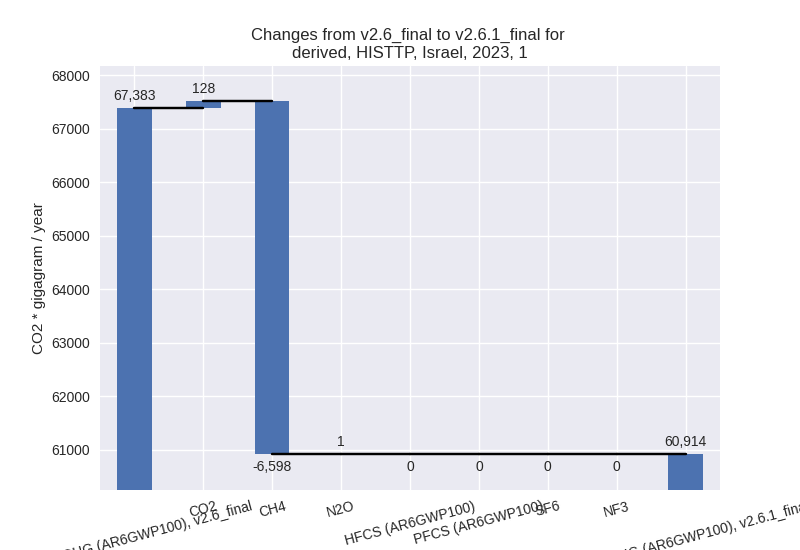
For 1990-2023 the changes per gas are: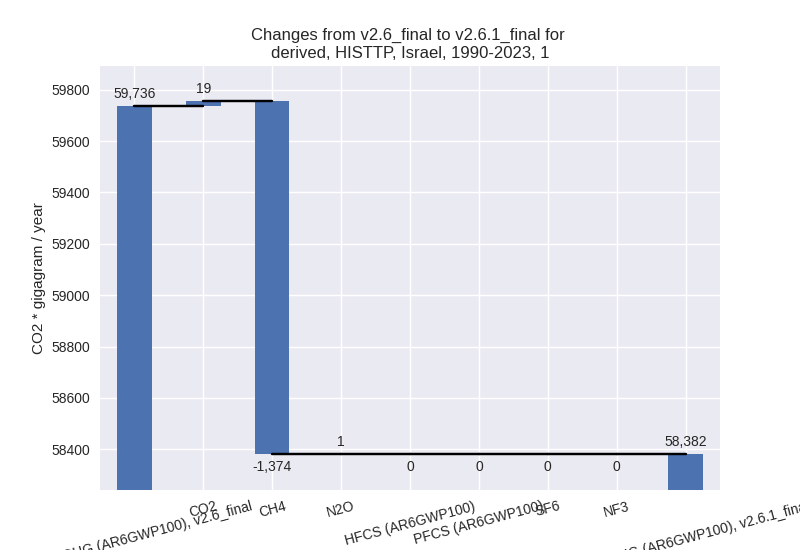
The changes come from the following subsectors:- 1.A: Total sectoral emissions in 2022 are 61804.35 Gg CO2 / year which is 99.0% of category 1 emissions. 2023 Emissions have changed by 0.0% (19.60 Gg CO2 / year). 1990-2023 Emissions have changed by 0.0% (6.95 Gg CO2 / year).
- 1.B.2: Total sectoral emissions in 2022 are 604.50
Gg CO2 / year which is 1.0% of category 1 emissions. 2023 Emissions have
changed by -90.6% (-6488.23 Gg CO2 /
year). 1990-2023 Emissions have changed by -86.0% (-1361.20 Gg CO2 / year). For 2023
the changes per gas
are:
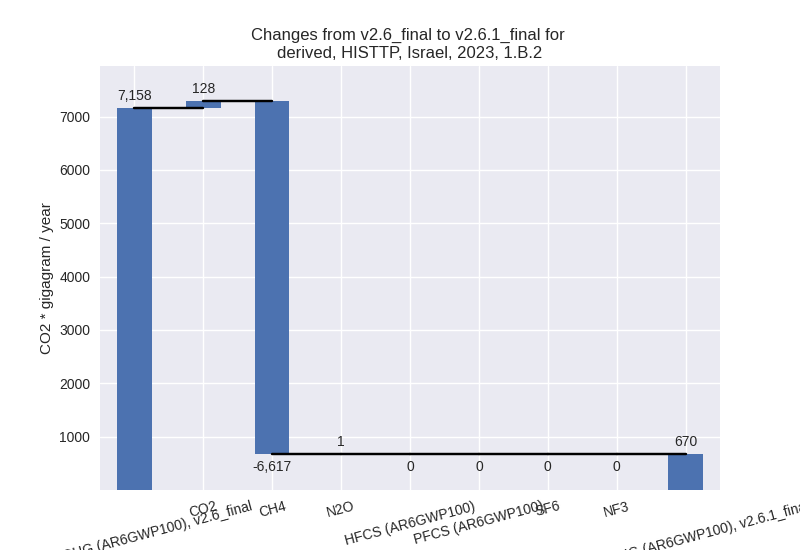
For 1990-2023 the changes per gas are: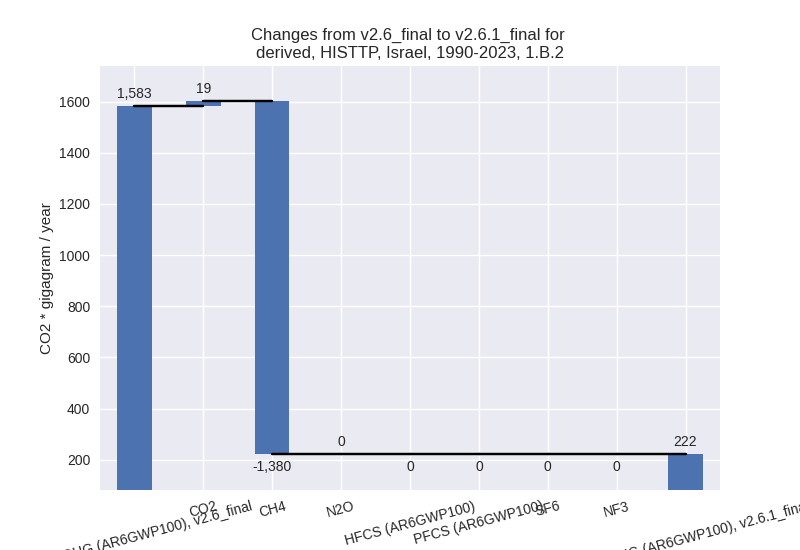
There is no subsector information available in PRIMAP-hist.
- 2: Total sectoral emissions in 2022 are 9984.56 Gg
CO2 / year which is 12.2% of M.0.EL emissions. 2023 Emissions have
changed by 3.1% (311.26 Gg CO2 /
year). 1990-2023 Emissions have changed by 0.7% (39.75 Gg CO2 / year). For 2023 the
changes per gas
are:
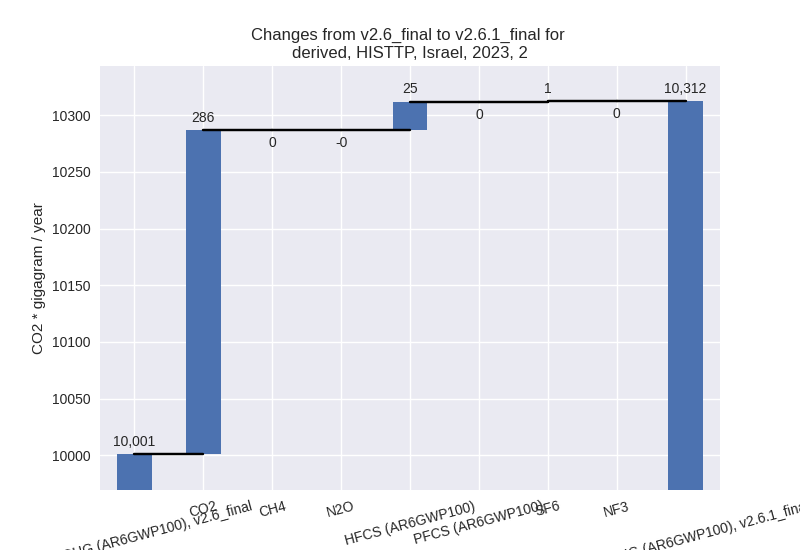
- M.AG: Total sectoral emissions in 2022 are 2001.51
Gg CO2 / year which is 2.4% of M.0.EL emissions. 2023 Emissions have
changed by -5.2% (-109.02 Gg CO2 /
year). 1990-2023 Emissions have changed by -0.6% (-10.03 Gg CO2 / year). For 2023 the
changes per gas
are:
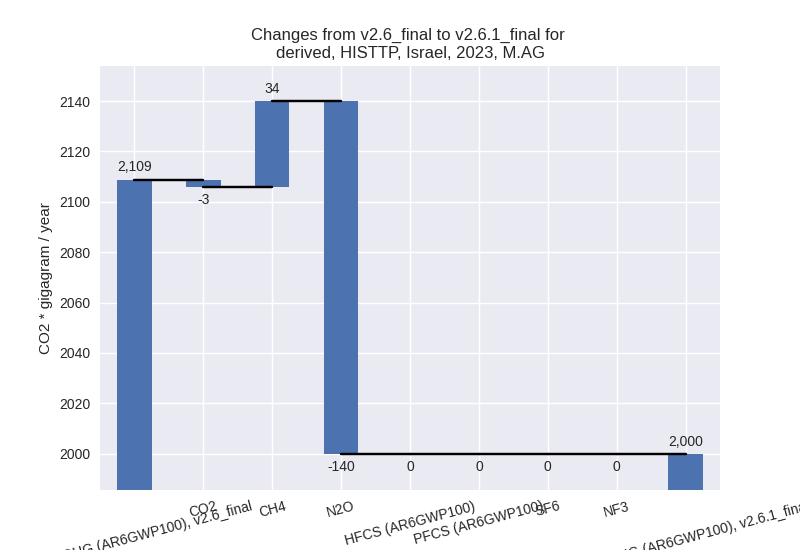
The changes come from the following subsectors:- 3.A: Total sectoral emissions in 2022 are 974.66 Gg
CO2 / year which is 48.7% of category M.AG emissions. 2023 Emissions
have changed by 3.5% (32.93 Gg CO2 /
year). 1990-2023 Emissions have changed by 0.5% (3.60 Gg CO2 / year). For 2023 the
changes per gas
are:
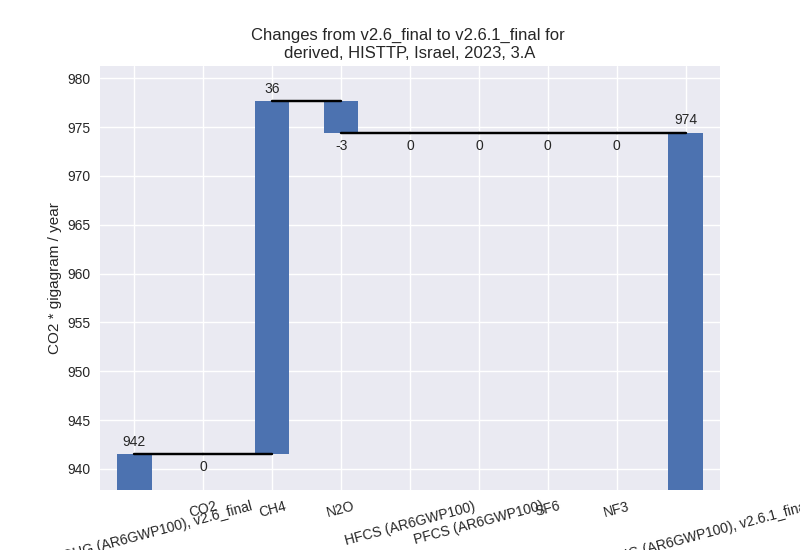
There is no subsector information available in PRIMAP-hist. - M.AG.ELV: Total sectoral emissions in 2022 are
1026.85 Gg CO2 / year which is 51.3% of category M.AG emissions. 2023
Emissions have changed by -12.2%
(-141.95 Gg CO2 / year). 1990-2023 Emissions have changed by -1.4% (-13.63 Gg CO2 / year). For 2023 the
changes per gas
are:
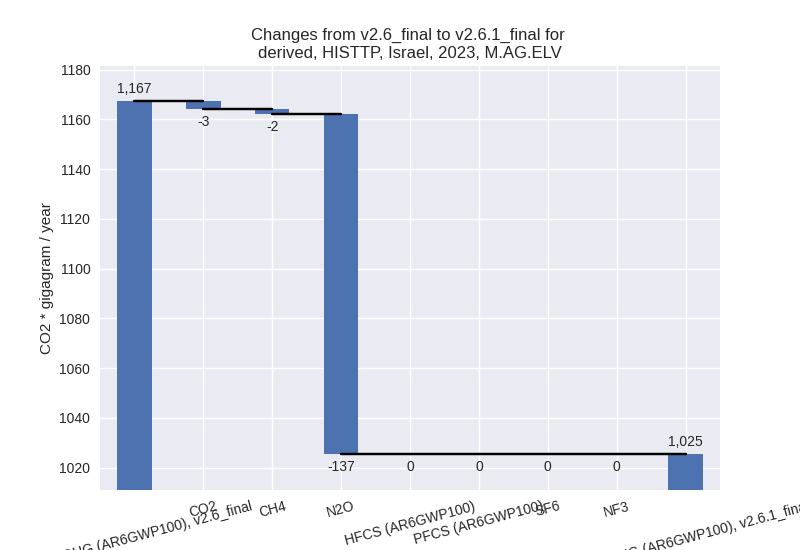
There is no subsector information available in PRIMAP-hist.
- 3.A: Total sectoral emissions in 2022 are 974.66 Gg
CO2 / year which is 48.7% of category M.AG emissions. 2023 Emissions
have changed by 3.5% (32.93 Gg CO2 /
year). 1990-2023 Emissions have changed by 0.5% (3.60 Gg CO2 / year). For 2023 the
changes per gas
are:
- 4: Total sectoral emissions in 2022 are 7283.92 Gg
CO2 / year which is 8.9% of M.0.EL emissions. 2023 Emissions have
changed by -17.8% (-1608.07 Gg CO2 /
year). 1990-2023 Emissions have changed by -17.0% (-1131.86 Gg CO2 / year). For 2023
the changes per gas
are:
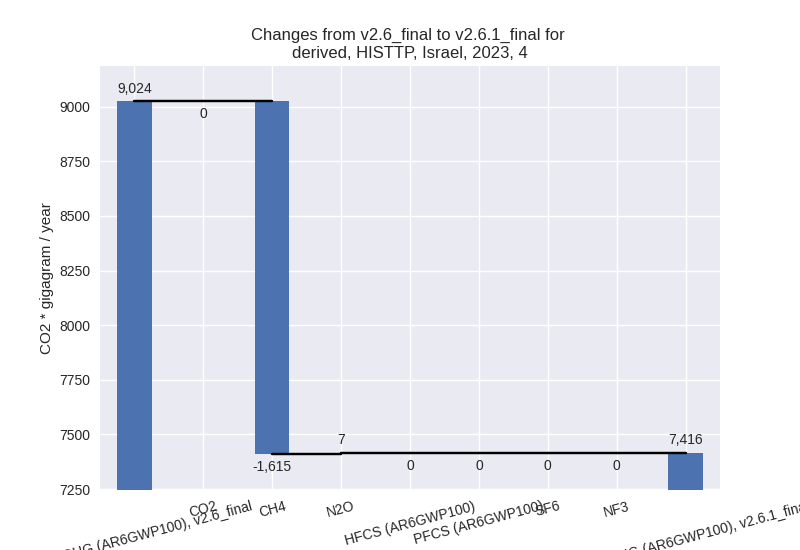
For 1990-2023 the changes per gas are: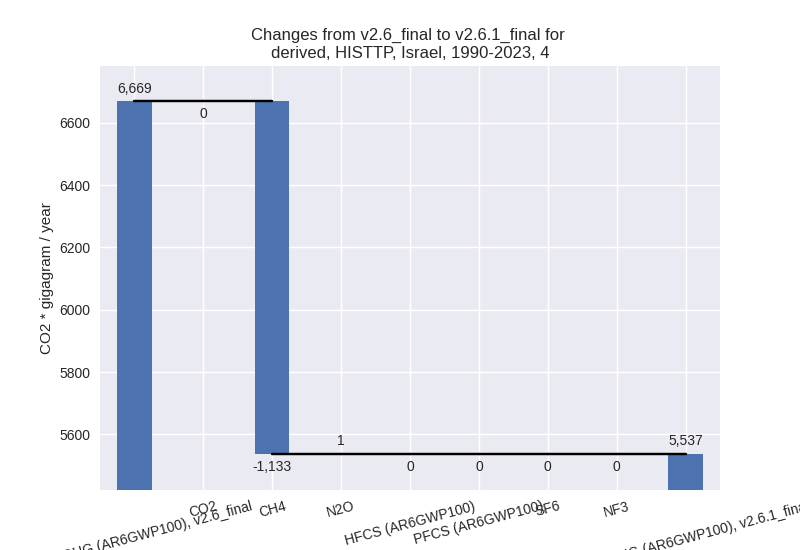
- 5: Total sectoral emissions in 2022 are 196.34 Gg
CO2 / year which is 0.2% of M.0.EL emissions. 2023 Emissions have
changed by -32.6% (-93.16 Gg CO2 /
year). 1990-2023 Emissions have changed by -18.7% (-58.46 Gg CO2 / year). For 2023
the changes per gas
are:
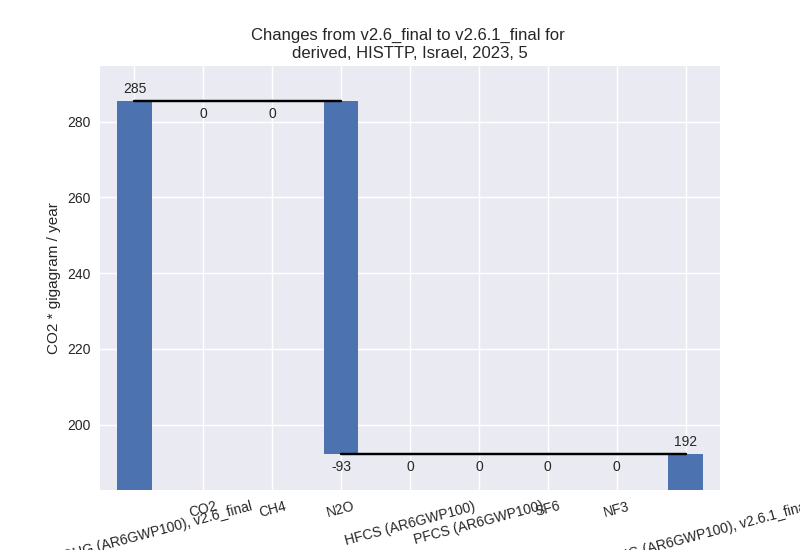
For 1990-2023 the changes per gas are: